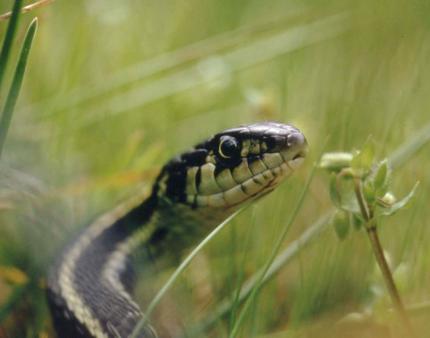
Snakes are among the most misunderstood of all animals. As a result, many harmless, beneficial snakes have met untimely deaths at the hands of shovel-wielding humans. Of the dozen or so species of snakes found in Washington, only the Western rattlesnake is capable of inflicting a venomous bite, which it seldom does.
Snakes should be left alone, and except for a rattlesnake that poses an immediate danger to people or pets, no snake should ever be killed. Observe snakes, like all wild animals, from a respectful distance. Don’t attempt to capture them, and don’t keep wild ones as pets.
All snakes are an important part of the natural food chain, eating a variety of prey—from mice and birds to frogs and insects. Besides their ecological value, snakes offer the careful wildlife viewer a chance to watch one of nature’s most efficient predators.
Facts about Washington snakes
Food and Feeding Behavior
- Snakes are predators and eat many animals thought to be pests—mice, voles, snails, and slugs. Other prey items include insects, bird eggs and nestlings, fish, frogs, and lizards.
- Snakes have hinged jaws that allow them to consume food that is wider than their bodies. Even so, what a snake eats depends on its size; generally, larger snakes eat larger food items.
- Snakes have forked tongues that deposit air molecules on receptors in the mouth; thus, snakes “taste” the air, which helps them locate prey and sense their way in the dark.
- Snakes store food as fat, and can live off their fat reserve for extended periods of time.
Shelter and Hibernation Sites
- Snakes in Washington hibernate during winter, either alone or in a group site called a hibernaculum.
- Hibernation sites (snake dens) are also used for shelter at other times, and include rodent burrows, spaces under logs and tree stumps, rock crevices, and lumber and rock piles.
- Hibernation sites must remain warm enough to prevent death by freezing, they must be neither too dry nor too wet, and they must be adequately ventilated.
- Snakes will use the same hibernaculum year after year; several hundred snakes and different species may occupy the same hibernaculum.
- Emergence from hibernation can begin as early as March, depending on the species and location. Snakes may temporarily emerge from hibernation to feed and bask during warm periods in mild areas.
Reproduction
- Courtship and mating occurs shortly after snakes emerge from hibernation.
- Garter snakes, rubber boas, and Western rattlesnakes bear live young from eggs retained in the body until hatching. All other Washington snakes lay eggs in protected areas where the eggs receive enough external heat to hatch.
- Young are born from July through September, and fend for themselves after hatching.
- Young snakes grow rapidly, and reach sexual maturity in two or three years.
Mortality and Longevity
- Snakes are preyed upon by badgers, coyotes, foxes, opossums, raccoons, skunks, weasels, great blue herons, hawks, eagles, and owls.
- Near human habitation, humans, domestic cats and dogs, lawn mowers, weed-whackers, and vehicles fatally wound or kill snakes.
- Garter snakes have lived as long as 18 years in captivity. Such ages might be exceptional for wild snakes, but little is known on this subject.
Common snakes of Washington
Three species of garter snakes occur in Washington. Small garter snakes eat earthworms and slugs; larger snakes include amphibians, small rodents, nestling birds, and fish in their diet.
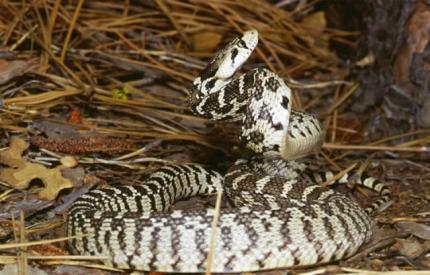
Garter snakes survive in suburbia and towns because they give birth to live young, and so do not require safe places for their eggs. Their name comes from their alleged resemblance to the garters once worn by men to hold up their socks.
When disturbed, garter snakes will try to escape, but if threatened they may strike, bite, and smear foul-smelling anal secretions on your hands. A bite from one of these nonvenomous snakes may be alarming, but will rarely break the skin.
The common garter snake (Thamnophis sirtalis, Fig. 1) is found from coastal and mountain forests to sagebrush deserts, usually close to water or wet meadows or your garden. Next to the Northwestern garter snake, this species is the most frequently encountered snake. It has brightly colored stripes (yellow, green, blue) that run lengthwise along its body, and a grayish-blue underside. It grows to 2 to 3 feet.
The Western terrestrial garter snake (Thamnophis elegans) occurs in a wide variety of habitats and, despite its name, it spends a lot of time in water. This garter snake is usually gray-brown or black, with a dark, checkered pattern between yellow stripes. Identification difficult because there are four subspecies, all varying in coloration. Nearly black forms occur in some areas. It can grow to a length of 40 inches.
The Northwestern garter snake (Thamnophis ordinoides) is somewhat less widespread than its two cousins, preferring coastal and mountain forest habitats. However, it is commonly found in suburban areas and city parks. It’s more slender than other garter snakes, reaching 2 feet at maturity. It is dark above and has stripes of varying colors, often red and orange.
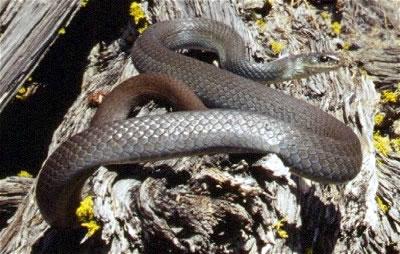
The gopher snake (Pituophis catenfe, Fig. 2), also known as the bull snake, is found in warm, dry habitat—deserts, grasslands, and open woodlands. It’s a robust snake, measuring 3 to 4 feet in length, with dark blotches against tan along its back.
The gopher snake is often mistaken for a rattlesnake, owing to its coloration and its impressive display of coiling, striking, and loud hissing. It will also vibrate the tip of its tail in dry grass and leaves, further mimicking a rattlesnake. However, it is not venomous. It is a constrictor, killing prey—mostly small rodents—by squeezing them until the prey suffocates.
The similar looking but rarely seen night snake (Hypsiglena torquata) occurs in similar habitats in eastern Washington.
The racer (Coluber constrictor) occurs in warm, dry, open or brushy country where it is often observed streaking across roads. It is about 3 feet long, plain brown or olive above, with a pale yellow belly. It is thinner than a garter snake of comparable size. The racer is well named because it can move extremely fast. It holds its head and neck above the ground when hunting, and may climb into shrubs.
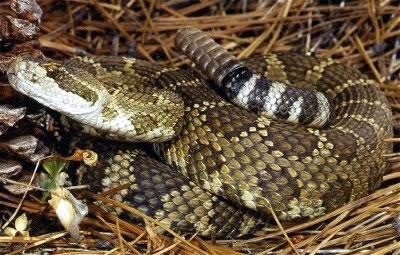
The Western rattlesnake (Croatus viridis, Fig. 4) is common in much of eastern Washington. It is distinguished by its broad, triangular head that is much wider than its neck, the diamond-shaped pattern along the middle of its back, and the rattles on the tip of its tail. Overall color patterns differ with habitat, ranging from olive to brown to gray. Black and white crossbars may occur on the tail. Western rattlesnakes measure 18 inches to 4 feet at maturity. Although many people talk of seeing “timber rattlers,” “diamondbacks,” and “sidewinders,” none of these occur in Washington.
The number of segments on the rattle does not indicate the true age of the snake, since rattlesnakes lose portions of their rattles as they age.
Rattlesnakes are most common near their den areas, which are generally in rock crevices exposed to sunshine. They are most likely to be seen at night and dusk during the spring and fall when moving to and from hibernation sites.
Rattlesnake fangs are hollow and are used to inject the snakes’ venom in order to stun or kill their prey—mice, woodrats, ground squirrels, and young rabbits and marmots. Their fangs are shed and replaced several times during their active season. Fangs may also be lost by becoming embedded in prey, or be broken off by other means.
Rattlesnakes cannot spit venom; however, venom may be squirted out when the snake strikes an object such as a wire fence. This venom is only dangerous if it gets into an open wound and has been used in the development of several human medications.
Rattlesnakes do not view humans as prey, and will not bite unless threatened. A rattlesnake bite seldom delivers enough venom to kill a human, although painful swelling and discoloration may occur. (For more information, see Rattlesnakes) link to below
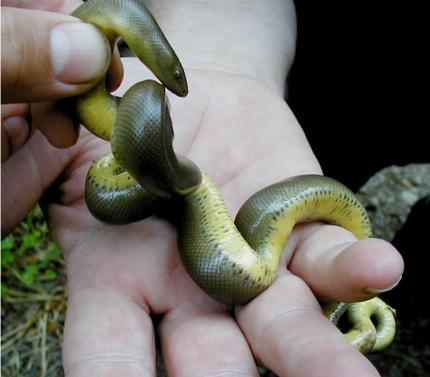
The rubber boa (Charina bottae, Fig. 5) is a member of the same family as the world’s largest snakes—including the boa constrictor, python, and anaconda. However, our local species only measures 14 to 30 inches. It is olive-green, reddish-brown, or tan to chocolate-brown. It looks rubbery and has a short, broad snout and a short, blunt tail, giving it a two-headed appearance.
The rubber boa is found in damp wooded areas, large grassy areas, and moist sandy areas along rocky streams, being particularly fond of rotting stumps and logs. Although seldom encountered, this snake can be common in appropriate habitat.
Viewing snakes
All snakes tend to be inconspicuous, preferring to move away and hide or lie still in the hope of being overlooked. Most encounters are momentary. Although snakes are often seen as threatening, they will hiss, strike, or bite only if they are cornered or restrained.
Most of the time, snakes are slow moving, but they can make short dashes to chase prey or escape from predators. They are unable to sustain long-distance movement.
Because snakes are particularly active and less wary during the breeding season, begin to be on the lookout for them in spring.
Snakes are often inactive during the hottest part of the day, especially in mid- to late summer, and seek shelter or crawl underground to avoid overheating. In desert areas, snakes may become active at night when the air cools, and while the ground remains warm. Night snakes, as the name implies, are almost always nocturnal.
It is environmentally unsound to capture snakes and try to relocate them on your property, or keep them as pets. Due to their well-developed homing instincts, most snakes will soon leave an unfamiliar area, which usually results in their being killed on the roads or by predators.
Basking Sites
Most snakes reach their preferred body temperature by basking on surfaces exposed to sun. They control their body temperature by moving in and out of the sunlight, and by changing their orientation to it (facing the sun, back to the sun, etc.). They also derive body heat by lying on or under warm surfaces.
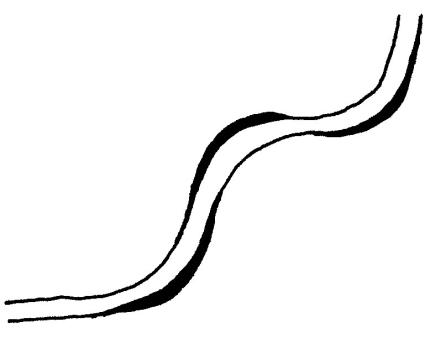
In hot areas, look for snakes basking in the morning sun on asphalt, concrete, rocks, and wooden fences. In cooler regions, they can be seen basking throughout the day. Snakes tend to bask on sun-warmed roads in the evening, a fact that often leads to them being run over.
Trails
Snakes trails are most easily seen in sandy or dusty areas in their preferred habitats. Snake tracks may be wavy or straight lines (Fig. 6). Surface material is usually pushed up at the outside of each curve.
Droppings
Snake droppings are interesting in that you will find a capping of white calcareous deposits at one end, as in the case of birds. The size of the droppings corresponds to the size of the animal. Snake droppings are cordlike, with constrictions and undulations.
Shed Snake Skin
A growing snake sheds its skin every four to five weeks. You can tell when it is ready to shed—its eyes look bluish-white and dull. Snakes may even become temporarily blinded until the old skin splits at the head, and they are able to crawl out. Shed skin looks like thin, clear plastic, with every detail of the scales still visible, even the eyeball cover. Look for shed skin under boards, in rock piles, and other places where snakes congregate.
Tips for attracting snakes
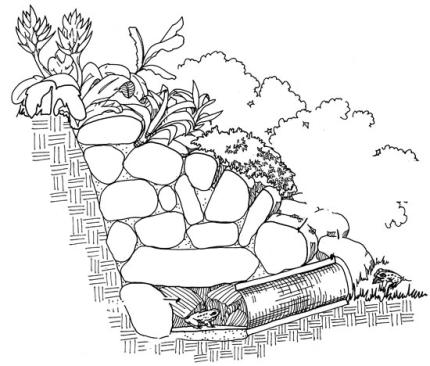
In addition to the persecution snakes experience routinely at human hands, they have suffered greatly from the habitat alterations we have created. Snakes fare poorly when we break up natural lands for urban and suburban development and isolate animals that cannot easily move across inhospitable terrain.
To help prevent this and to safe spaces on your property for snakes:
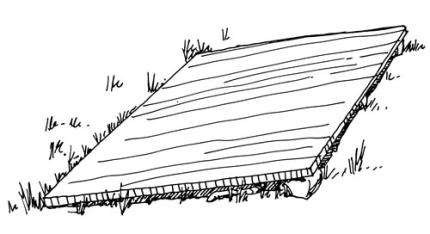
- Protect hibernation sites and other areas used by snakes.
- Mow at slow speeds and be ready to step on the clutch or brake. Leave grass unmowed in places that adjoin a wet area, sunny forest edge, or any other known snake habitat. If the grass has to be cut, survey the area and move or direct any snakes to a safe location prior to mowing. Set the mower blades as high as possible, or use a weed-whacker and leave grass 6 inches high.
- Build a small, fish-free (fish eat all stages of amphibians) pond for amphibians. Many snakes, and garter snakes in particular, feed on tadpoles, adult frogs, and invertebrates found in and around ponds (see sources of information on ponds).
- Build a rock wall or a rock pile with crevices for snakes to escape from severe weather and predators, to find food, and to give birth (Fig. 7).
- Create a “snake board” by laying a sheet of plywood or corrugated sheet metal on the ground in a sunny location, propping it up on three sides with 3-inch rocks, lengths of plastic pipe, or similar objects (Fig. 8). In cool areas, paint the top black or cover it with dark asphalt shingles to increase the temperature below the board.
- Place habitat-enhancement features, such as snake boards and rock piles, away from driveways or heavily traveled roads to avoid vehicle/reptile unpleasantries.
- Discourage cats and dogs from using your yard. They are effective hunters and can severely impact snake populations.
- Encourage your friends and neighbors to preserve wildlife habitat on their property, especially property that adjoins yours.
- Support public acquisition of greenbelts, remnant forests, and other wild areas in your community.
- Join a local conservation organization or a habitat enhancement project.
Preventing conflicts
Because of much false teaching, many people dread snakes, and consequently control often is practiced when it is not needed. The first thing you should do when encountering a snake is to leave it alone. Next, as long as it is not a rattlesnake or inside a house or building where it is not wanted, continue to leave it alone. The chances that the animal will ever be seen again are fairly small.
If a snake gets into a house or other building, remain calm to avoid disturbing it and forcing it into hiding. Several methods are available to remove it. First, try opening a nearby door and using a broom to gently herd the animal out. You can also use a long pole, stick, or golf club to pick a snake up and place it in a box or wastebasket for transport outdoors.
If you are squeamish, the snake can be confined in a room or corner with barriers, such as boards or boxes, to be available for capture by a neighbor or an experienced handler. If possible, place an empty pail or wastebasket slowly over a small or coiled snake until someone less squeamish arrives.
If someone else isn’t available to remove the snake, you can hire a wildlife control company to do the job. To find such help, call your local wildlife office for a referral or look under “Animal” or “Wildlife” in your local phone directory. Police or fire departments sometimes remove rattlesnakes.
To prevent conflicts with snakes:
Prevent Entry into Buildings
Snakes in houses fall into two categories: those that entered accidentally and will be attempting to escape because they find the habitat unsuitable, and those that have entered to find prey or shelter and would take up permanent residence if allowed. The former includes small snakes that may be considered trapped and will likely die from lack of food or moisture if not captured and removed. Some snakes may hibernate in older houses with leaky cellars or crawl spaces with dirt floors. The presence of shed skin usually indicates that a snake has been living in the house for some time.
Snakes usually enter at ground level, so sealing all ground-level holes or cracks can prevent their entry. Seal all cracks and holes in building foundations and exterior walls, including warped siding, where a small snake could enter. Use 1/4-inch mesh hardware cloth, caulk, mortar, or a concrete patch to make the seal.
Snakes can find easy access to garage areas through open garage doors or under poorly fitting doors. Cover door bottoms with metal flashing or another material. Any weather-stripping along the garage and other outside doors should fit tightly. These modifications will also exclude mice and other rodents.
Modify the Habitat
To limit the number of snakes around a living structure, reduce their food supply, shelter, and encourage their natural predators. The reduction of shelter (rock piles, woodpiles, tall grass) not only limits hiding places, but also reduces the habitat used by mice and other rodents, which are a food source for snakes. (Snakes will also use holes made by mice or other rodents.) Mice and rat populations can be reduced by keeping food (including spilled seed under bird feeders) inaccessible to these animals.
While snakes don’t make up the majority of any predator’s diet, hawks, owls, and a wide range of mammals eat them. See the appropriate handout for information on how to attract species that feed on snakes.
Note: As the number of snakes is decreased, the number of ground squirrels, gophers, and other rodents may increase, resulting in a different variety of problems.
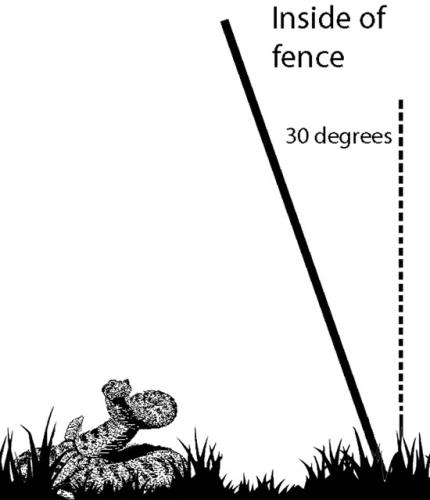
Fences and Repellents
In areas where rattlesnakes are commonly encountered, fences have been used to keep them away from buildings and out of yards (Fig. 9). This method is expensive, but if the yard is to be used as a playground by children the cost may be justified—if only to ease the worries of the parents.
A fence can be made from 1/4-inch mesh galvanized hardware cloth, 30 inches high. The bottom edge should be buried 3 to 6 inches in the ground and the support stakes should be inside the fence to prevent snakes from crawling up them. Such a fence also can be added in front on an existing fence. Any gates should fit tightly and be kept closed.
Regularly inspect the fence to be sure that holes haven’t been opened under it, and that items have not been piled against the outside. Keep grass and weeds around the fence mowed.
Snake repellents, such as Snake-A-Way© and the stronger Doctor T’s Snake Away© have produced mixed results. Snakes “smell” things via their tongues and the Jacobson’s organ, which is located in the roof of the mouth. But, unlike mammals, snakes have no sense of smell associated with their breathing cycle. This means that unless the snake just happens to poke its tongue out at the precise moment that it is moving over the repellent, it will not notice a thing. Even if it does, the smell may not be noxious enough to drive the snake in another direction.
Rattlesnakes
If you live in or visit rattlesnake country, be alert and aware of this species in order to avoid threatening it. Also know the recommended treatment steps in case a human or pet is bitten.
If you encounter a rattlesnake, move away: A rattlesnake will coil into a defensive posture if it cannot escape by crawling away. If you remain too close, the rattlesnake will usually warn you with its distinctive rattle. Its last defensive move is to strike. Remember, all of these warnings are meant to help avoid conflict. Rattlesnakes want to avoid you as much as you want to avoid them.
Prevent Problems While Hiking
- To minimize conflicts with rattlesnakes while hiking:
- Stick to well-used, open trails. In brushy areas, use a walking stick to alert a snake of your approach.
- Avoid walking through thick brush and willow thickets.
- Do not step or put your hands where you cannot see.
- Wear over-the-ankle boots and loose-fitting long pants.
- Watch rattlesnakes from a distance, and be aware of defensive behaviors that let you know you are too close.
Rattlesnake Bites
All rattlesnake bites should be considered life threatening. When someone has been bitten, time is of the essence. If possible, call ahead to the emergency room so anti-venom can be ready when the victim arrives.
If a rattlesnake bites a person or a pet, do the following:
- Keep the victim calm, restrict movement, and keep the affected area below the heart level to reduce flow of venom toward the heart.
- Wash the bite area with soap and water.
- Remove any rings or constricting items; the affected area will swell.
- Cover the bite with a clean, moist dressing to reduce swelling and discomfort.
- Get medical help immediately. Make sure the doctor who treats the victim knows how to treat snakebites and, if not, call the Poison Center at (800) 222-1222.
Things not to do:
- Do not allow the person to engage in physical activity such as walking or running. Carry the victim if they need to be moved.
- Do not cut or suck the wound, do not apply ice or cold packs to the wound, and never use a tourniquet.
- Do not give the victim stimulants or pain medications, unless instructed by a physician.
- Do not give the victim anything by mouth.
- Do not raise the bite area above the level of the victim’s heart.
Trapping and Snakes
As a last resort, a snake can be trapped and moved outside, or a one-way door can be installed that will allow the snake to exit but not reenter.
A live trap can be made from a 24- to 36-inch section of 4-inch PVC pipe. Temporarily cap one end and close off the other end with a cap that has a 1-inch hole drilled through the center. Place a hand warmer and a soft cotton rag in the far end of the tube. The hand warmer warms the tube up and a cold snake will crawl inside. (In hot settings, place an ice pack or a cool wet rag in the tube.) If the PVC trap feels too hot or cool, drill a few air holes in the top of the tube to let some heat or coolness out.
Anchor the trap to prevent it from rolling. A tracking patch (a bit of flour) in front of the trap will confirm that a snake has entered. Place a piece of duct tape over the hole before moving the snake and trap outside.
Another trap is to attach three or four commercially available, rat-sized glue-boards to a piece of plywood. Place the glue board trap along an inside wall or foundation. When a snake moves over the glue board trap it will get stuck. Once the snake is attached, the glue board trap can be removed. To avoid close contact with an agitated snake, consider fastening a wood extension handle to the glue board plywood base before placing the trap. Note: Use glue boards only indoors or under structures and only where children, pets, or non-targeted wildlife can't reach them.
To release a snake caught in the glue board trap, take it to a suitable area, place the trap on the ground, and pour vegetable oil on the snake. The oil will reduce the tackiness of the glue and allow the snake to free itself. Note: Glue boards should not be used outdoors or at any location where they are likely to trap pets or other non-target animals.
To create a one-way door, seal all the openings except the suspected main entrance being used by the snake(s). On that opening, install a one-way door made from a piece of aluminum window screen rolled into a cylinder about 10 inches long and with a slightly larger diameter than the entrance hole. Suspend the outlet end of the tube off the ground to prevent the returning snake(s) from finding the entry. The device may be left in place for a month or longer to allow time for the snake(s) to leave.
Make any necessary repairs to the house or other structure to prevent the problem from reoccurring.
Additional information
Public Health Concerns
Non-venomous snakebites are harmless. The only concern may be for potential infection. If bitten, clean and sterilize the wound as you would a cut or abrasion. A few people may be allergic to what are usually harmless bites, such as those from a garter snake. Contact your physician if a rash or a sign of infection appears.
Legal Status
Several snake species in Washington hold special state status. Because their legal status is currently undergoing change, contact your local state Fish and wildlife office for updated information.
It is unlawful to import into the state, hold, possess, offer for sale, sell, or release all snake species into the wild without the proper license to do so (WAC 220-450-030).
Books
- Kozloff, Eugene N. Plants and Animals of the Pacific Northwest. Seattle: University of Washington Press, 1976.
- Link, Russell. Landscaping for Wildlife in the Pacific Northwest. Seattle: University of Washington Press and the Washington Department of Fish and Wildlife, 1999.
- Matson, Tim. Earth Ponds: The Country Pond Maker’s Guide to Building, Maintenance, and Restoration. Woodstock, VT: Countryman Press, 1991.
- Nash, Helen. The Pond Doctor: Planning and Maintaining a Healthy Water Garden. New York: Sterling, 1994.
- Nussbaum, Ronald A., et al. Amphibians and Reptiles of the Pacific Northwest. Moscow, ID: University of Idaho Press, 1983.
- Storm, R. M., and W. P. Leonard, eds. Reptiles of Washington and Oregon. Seattle: Seattle Audubon Society, 1995.